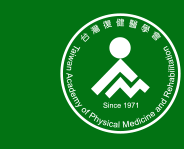Rehabilitation Practice and Science
Translated Title
雙側唇顎裂兒童之吞嚥治療:病例報告
Abstract
Other than craniofacial anomaly, children with cleft lip and palate usually have problems of speech and swallowing. Therefore, in addition to multiple sessions of operations for repair and reconstruction, active rehabilitation is also required to improve their function of speech and swallowing. This report disclosed a ten-year-old boy who depended on nasogastric tube feeding and respired via tracheotomy after birth because of bilateral cleft lip and palate as well as subglottic stenosis. He started training of swallowing and speech at the age of 8. However, having lacked adequate practice for a long period of time, coordination and strength of his muscles for swallowing were inappropriate. Furthermore, concurrent hearing impairment and developmental delay perplexed performance of the rehabilitation program. Treatment included thermal-tactile stimulation, changing posture of swallowing, oral and laryngeal exercise, neuromuscular electric stimulation and using cleft palate prosthesis. After treatment, this patient does not experience significant nasal regurgitation and swallowing problems on taking most food (thin liquid, nectar-thick liquid and honey-thick liquid), except paste food that cumulates in his larynx and induces choking. Therefore, the nasogastric tube was removed and this patient can be fed orally. The therapeutic process may be the reference of the clinical practice in the other similar patients.
Language
Traditional Chinese
DOI Link
https://doi.org/10.6315/2011.39(2)08
First Page
123
Last Page
129
Recommended Citation
Chang, Shih-Chung; Yang, Ching-Ching; and Huang, Yu-Hui
(2011)
"Swallowing Therapy in Children with Bilateral Cleft Lip and Palate: A casereport,"
Rehabilitation Practice and Science: Vol. 39:
Iss.
2, Article 8.
DOI: https://doi.org/10.6315/2011.39(2)08
Available at:
https://rps.researchcommons.org/journal/vol39/iss2/8


